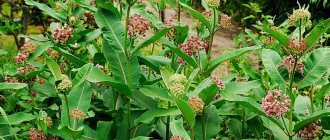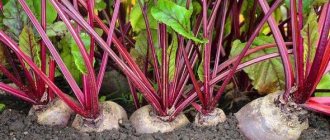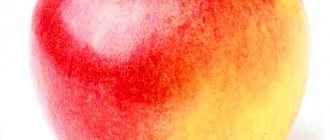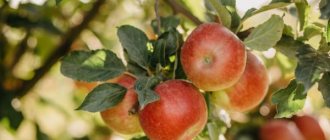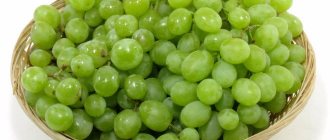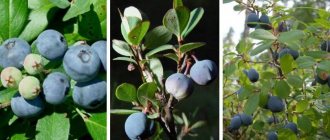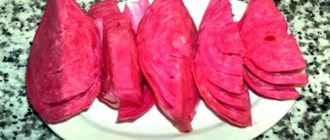Millions of farmers know that growing and caring for fodder beets is the most profitable business in their working life. Crop yield indicators, depending on the variety, can range from 85 to 1,200 centners per hectare.
In addition, the root vegetable contains many vitamins and microelements that promote digestion and rapid absorption of dry food. Moreover, in the summer months, animals can be given not only fruits, but also the tops of the plant. In this regard, it is worth learning some of the nuances of planting and the features of caring for it.
Fodder beet is successfully used as a unique product that increases milk yield in cows and goats. At the same time, the vegetable does not harm the health of livestock at all.
Description of culture
Fodder beet is a biennial crop. In the first year, a thickened root crop and a rosette formed by basal leaves grow. In the second year of growth, flower stalks appear, producing fruits with seeds.
Description of the plant:
- Roots. They can have a bag-shaped, oval-conical, cylindrical or spherical shape. Average weight – 0.5-2.5 kg. Root vegetables can have different colors - red, pink, yellow, greenish-white, purple, orange.
- Escape. In the first year of life, the crop grows a lush rosette of heart-shaped green leaves. Socket height – up to 1 m.
- Inflorescences. Paniculate inflorescences grow on leafy peduncles in which seeds ripen.
Advantages and disadvantages
The feed crop in question has pros and cons that are useful for livestock farmers to know about.
Advantages of fodder beet:
- ideal for feeding livestock;
- high productivity;
- helps improve animal digestion;
- increases soil fertility, reduces weed infestation;
- has lactic properties.
Flaws:
- Regular watering and fertilizing are required;
- demands on soil quality;
- relatively low protein content;
- if you give a dairy cow more than 10 kg of beets per day, the fat content of the milk decreases and its taste deteriorates;
- the need to change the growing location every year.
Is it possible for people to eat
Due to the large amount of fiber and fibre, this industrial crop is poorly absorbed by the human body. In addition, it is not very tasty and takes a long time to cook. Table beets and sugar beets are suitable for culinary purposes. By the way, a decoction of the latter is known as a good auxiliary remedy for tuberculosis. In addition, beets increase hemoglobin and are perfect for various diets.
Comparison of fodder and sugar beets
The two related crops have a lot in common, but there are also plenty of differences between fodder and sugar beets.
Comparison of fodder and sugar beets:
| Signs | Stern | Sugar |
| Appearance | The fruits are dark, the leaves are shiny. | Differs in a large number of leaves. |
| Root growth | The degree of immersion in the ground depends on the variety. | The fruit is completely in the soil. Has a more powerful root system. |
| Usage | Feed for livestock. Both roots and tops are used. | For the production of sugar. Tops and root crops can be used as feed. |
| Compound | Inferior in energy value. | 20% more sucrose. |
How to choose?
The choice of the type of vegetable depends on the purpose of its use.
If beets will be used primarily in cooking, you should choose table beets. Excellent taste and delicate pulp will make any dish tastier and more enjoyable. The best borscht is made from beets, and salads are made from its leaves. Among the beneficial properties, one can highlight protection against heavy metals, removes cholesterol and helps prevent intestinal diseases. Table beets are the best type of beet for cooking.
Sugar beets can be eaten; those people who like sweeter foods and dishes add it instead of canteen. Sugar beets have a number of beneficial properties:
- improves metabolism (promotes weight loss even despite the high sugar content);
- cleanses and rejuvenates the body;
- improves thyroid function;
- has anti-inflammatory and preventive effects.
Sugar beets are a storehouse of nutrients and vitamins.
Fodder beet is not suitable for humans, but is suitable for animals. You can achieve enormous success in milk yield by feeding your cattle fodder beets. It also serves as a source of vitamins and minerals in winter. Fodder beet is also a material for the work of breeders (it is from it that sugar beet was bred).
Fodder beet is the best type for feeding animals to obtain a large amount of milk and for the health of livestock (you can learn about the peculiarities of using fodder beet by animals here).
The main differences between fodder beet and sugar and regular beets:
- size (feed is usually large);
- position in the ground (the stern “looks out”);
- tops (they are much thicker and more magnificent at the stern);
- purpose (fodder is grown for animals, table and sugar can be eaten);
- chemical composition (contains approximately eight times more protein);
- taste (taste is worse);
- fruit shape (variety of shapes. Unlike table beets, easy to recognize).
Fodder beet varieties
The varieties of fodder beet cultivated by farmers differ in terms of ripening, shape and color of root crops.
Jamon
Productivity – 80-85 centners per 1 ha. The shape of the root crop is cylindrical-conical. Medium sized fruits. Orange color. Weight – up to 5 kg. Immersed in the ground by 30%. The pulp is white and juicy. Root crops are shelf-stable - stored until May.
Starmon
Productivity up to 70 tons per hectare. Does not grow on saline and acidic soils. The rosette of the plant is erect, the leaves are elongated. The shape of the fruit is conical. Fruit color: underground part - yellow, aboveground part - green. Average weight – 10 kg.
Lada
The variety has good keeping quality. Productivity – 120 tons per 1 hectare, maximum – 170 tons per 1 hectare. The variety is slightly susceptible to flowering. Weight – up to 10 kg. Color – white or pinkish-white. The pulp is juicy, white and dense.
Milan
Hybrid of Belarusian selection. The yield of root crops is up to 140 tons per 1 ha. The lower part of the root crops is white, the above-ground part is green. The rosettes are erect, the leaves are medium wide, with white veins. Root crops are 60% buried in the soil. It has a low degree of soil contamination. Root crops are short-lived and stored until the end of spring.
Poly's record
Multi-sprouting mid-late variety. Productivity – up to 130 tons per hectare. Root crops are 40% immersed in the soil and are slightly contaminated with soil. Color – pink-red. The pulp is juicy and white. The weight of root crops is up to 6 kg.
Eckendorf yellow
Cold-resistant variety. Productivity – up to 150 tons per 1 ha. The variety is resistant to flowering and does not form shoots. The roots are yellow, immersed 30% in the soil. Weight – up to 900 g.
Preparatory work
To grow large fodder beet roots, you need to properly prepare the soil and seeds.
Where to plant beets?
The culture grows well on soils with a neutral and slightly acidic reaction (up to 7.5 pH). On swampy, clayey, rocky and sandy soils, growing fodder beets does not produce the expected yields.
Beets grow well after grains, corn and vegetables. The best predecessors in forage crop rotations are:
- silage corn;
- cereal-bean mixture;
- melon crops.
You can replant fodder beets in one field after 3 years, not earlier.
Soil preparation
The crop is demanding on soil fertility, so before sowing it is necessary to carefully prepare the soil, improve its structure and composition.
The procedure for preparing soil for sowing:
- Clear the area of weeds. Water the weeds, and after two weeks, when new shoots appear, repeat weeding. To get rid of perennials - wheatgrass and thistle, treat the area with herbicides, for example, Buran or Roundup.
- In the fall, add organic matter when digging. For 1 hectare - 35 tons of humus or compost and 0.5 tons of ash.
- Before planting, dig up the soil again, adding nitroammophoska - 15 g per 1 linear meter.
The ideal soil for sowing fodder beets is loose, moist with small lumps.
Seed preparation
To prevent the seeds from rotting in the ground, they must be processed. The treatment will also prevent many diseases.
Processing order:
- Soak the seeds in a saturated solution of potassium permanganate. 30 minutes is enough.
- To ensure that the seeds germinate at the same time, place them in a growth stimulator.
- Dry the seeds.
Growing process
The entire process of cultivating a crop, like any other, is divided into several stages and activities. Each of them must be approached as scrupulously as possible and fulfill all the necessary requirements and rules. To summarize, the cultivation of fodder beets is divided into:
- Soil preparation.
- Sowing seed material.
- Agrotechnical measures.
- Protection from diseases and insects.
- Fertilizer application.
- Harvesting.
Growing process
Important! Each of the listed stages must be carried out in a timely manner, since it must correspond to a certain period of cultural development.
Soil preparation
The preparatory stage includes not only tillage, but also enrichment of the soil with necessary nutrients. If the soil chosen for cultivating the crop is black soil, sandy loam or loam, then additional fertilizing is not required.
Land for sowing
If, due to the lack of a fertile area, an area with poor soils is chosen, then the application of fertilizers is mandatory. Soil treatment includes the following points:
- removal of weeds. It is necessary to make the area as clean as possible from weeds, since this will facilitate both the process of further processing and increase the competitiveness of the crop;
- in the case where a large amount of weeds belonging to the family of cereals or dicotyledonous annuals is observed on the site, then weeding is carried out in two approaches with a difference of 14 days.
If perennial weeds grow on the soil, then it is necessary to carry out treatment in the autumn in advance, using continuous herbicides. Below are the drugs, as well as methods of application and their concentration for effective weed control; Weeds on the beet plot - in the autumn, when the area for sowing is being dug up, fodder beets require the application of compost in the amount of 35 tons per 1 ha, in combination with 5 quintals of wood ash;
- Before you start sowing seed, you need to dig up the soil again and add nitroammophoska. The amount of fertilizer is calculated based on the proportion of 15 g per 1 m²;
Nitroammofoska
Important! It is best to choose for sowing fodder beets the area where legumes, vegetables, cereals, or corn previously grew. It is not recommended to grow this crop without taking into account the specified crop rotation; this promises a strong development of pests and diseases on it.
Weed control
This table indicates the preparations and the timing at which they must be applied to the soil throughout the entire period of crop development or until sowing.
| Weeds | Payment deadline | A drug |
| Family Poaceae Dicotyledonous annuals |
|
|
| Annual dicotyledons |
|
|
It is necessary to apply chemicals to kill weeds only in dry weather conditions and at temperatures not exceeding 25 degrees Celsius. The time of day for such events must be chosen, either early in the morning or late in the evening.
Herbicide treatment
Important! The most effective way to get rid of weeds in a beet area is to re-apply the chemical at intervals of 7-14 days. Determine the exact time for application, based on germinating weeds.
Herbicide prices
Herbicides
Sowing
Before you start sowing the material, it is necessary to prepare it. To do this, first of all, it is necessary to treat the seeds with a disinfection solution. It is necessary to immerse the seed material in such a solution for at least half an hour. Additionally, you can use special growth stimulants that will ensure the highest possible percentage of germination.
Also necessary for the successful germination of seeds is their treatment with chemicals that have a fungicidal and insecticidal effect. Treating must be carried out no later than a five-day period before sowing. The drugs that can be used for such purposes are the following:
- TMTD 10 kg/t;
- Tachigaren 5 kg/t;
- Furadan 30 kg/t.
If seeds are purchased in specialized stores or from a farmer, then there is no need to resort to dressing measures. Beet seeds are pre-calibrated and treated with chemicals.
Type of uncalibrated, untreated seeds
They begin to directly sow the soil at the moment when its temperature at a depth of 5 cm reaches 6 degrees Celsius. This is relevant for those fodder beets that are subsequently needed for feed purposes. The duration of the sowing period should not exceed 1 week. Regarding the seeding rate, it varies depending on the type of crop cultivation:
- if a mechanized method is chosen for growing beets, then the seeding rate is 120-130 thousand pieces/ha;
- in the case of further manual thinning of the site, the number of seeds per 1 hectare is 200-250 thousand.
The depth to which the seed is planted varies depending on the type of soil:
- heavy soils, which are characterized by high levels of humidity, require planting seeds to a depth of 3 cm;
- if the soil is sandy loam or light loamy, which is not characterized by swimming, then the depth of embedding is 4 cm.
During sowing, it is necessary to adhere to a certain row spacing, which is 45 cm. Butt row spacing in width should not exceed 50 cm.
Calibrated, processed seeds
Video - Planting beets
Crop care (agricultural technology)
In addition to the fact that beets need regular watering, they require compliance with the following rules:
- it is necessary to weed the beds every time as soon as weeds begin to grow;
- After the plants form their first pair of true leaves, it is important to begin thinning out dense areas. During which process is it necessary to remove weak and thin plants, leaving a distance between them of 25 cm;
- Every time the soil is moistened, it does not matter whether it is done by watering or it has rained, beet crops require immediate loosening between the rows. This technique is necessary to preserve the natural process of circulation of air masses and ensure free access of oxygen to the roots of the plant;
- the regularity of watering can be determined by specific weather conditions and soil conditions;
- 3 weeks before harvest, watering is stopped. This is necessary for hardening the root crops, which will later be sent for storage. This technique allows you to increase the degree of their keeping quality.
Watering crops
Prices for walk-behind tractors and cultivators
Motoblocks and cultivators
Fertilizers
The exact rates of fertilizers that are necessary to ensure favorable conditions for the crop are determined in each specific case individually based on the soil and its composition. Fertilizer is applied according to the following dosages and timing:
- Nitrogen. The first time is applied during pre-sowing treatment in an amount of 80%, during the feeding period 20%. The total dose of fertilizers of this type varies from 120 to 150 kilograms per hectare.
- Phosphorus and potassium. Such fertilizers are applied in the autumn, during plowing, and in the spring, at the time of pre-sowing treatment. The number of the former is 90-120, the latter 150-200 kg/ha.
- Bor. This element is essential for obtaining good beet yields. Boric acid or any variation of complex fertilizers can be used as a fertilizer. The best option to apply boron to beets is the method of foliar feeding during the period of plant development of 3-4 leaves. The amount of fertilizer is 180-200 g/ha.
Beetroot 3-4 leaves
Protection of culture
There are a large number of specialized pests for this crop that cause significant damage to plants. They must be identified and removed from crops in time. The same applies to diseases that can manifest themselves both on root crops and on tops. The tables below indicate the periods during which it is necessary to inspect plants and treat them with special preparations.
Inspection of crops
Harvesting
The harvesting process can be carried out either using special equipment or manually. This mainly depends on the area that needs to be cleaned. To collect beets, special equipment is suitable, for example, a potato digger or a potato harvester.
Harvesting
The period considered optimal for beet harvesting is the end of September and the beginning of October. In any case, it is necessary to have time to remove root crops from the site before the temperature reaches 7°C.
Landing
The success of growing forage crops largely depends on the timeliness of sowing activities and compliance with the sowing scheme.
Deadlines
Fodder beets have a fairly long growing season - 120-150 days, so they need to be planted early - as soon as favorable weather conditions develop. Sowing of fodder beets begins after the soil warms up to +7°C, not earlier.
When determining sowing dates, take into account the characteristics of a particular variety and climate:
- Temperate regions. Sowing is carried out from March 15 to March 30. In case of unfavorable weather conditions, sowing work is postponed to the beginning of April.
- Northern regions. Beetroot is sown here from early April to mid-May.
Sowing
If the soil has warmed up to +7..+8°C and the seeds have been treated, you can start sowing.
Sowing order:
- Make furrows in the area at intervals of 60 cm from each other.
- Bury the seeds into the soil 3 cm. For 1 linear. m – 15 seeds.
- Cover the seeds with soil.
At a temperature of +8°C, seedlings appear in approximately 12-14 days, at +15°C - after 4-5 days. If the air temperature drops to minus 3°C, the seedlings may suffer.
Favorable days for harvesting beets from the beds in 2021
For summer residents and gardeners, a lunar calendar is proposed for harvesting beets for storage, digging them up in 2021, when digging beets is favorable from the point of view that they will be stored longer, and all thanks to the fact that the most optimal days for digging and harvesting from the beds have been chosen in terms of the placement of the Moon in the signs of the Zodiac and what you will learn about later, after the table of digging up root crops and harvesting beets from the beds.
| Month of cleaning | Favorable days for cleaning |
| Beet harvesting in July 2021 | from 23rd to 27th of the month |
| Beet harvesting in August 2021 | from the 19th to the 25th of the month |
| Beet harvesting in September 2021 | 8th, 9th, 16th to 21st, 25th and 26th of the month |
| Beet harvesting in October 2021 | from 3 to 6, 15 to 19, 22 to 25 days of the month |
Features of care
Agrotechnical measures:
- Watering. The frequency of watering depends on the weather and the growing season. Watering rules:
- the water rate increases during the period of growth and formation of root crops;
- One month before harvesting, watering should be stopped.
- Weed control. Up to 80% of the crop can be lost due to weeds. Weeding of the rows is carried out until the tops of the plants close.
- Thinning. The culture grows slowly during the first 1.5 months. But as soon as the seedlings have a pair of true leaves, thinning is carried out. There should be 4-5 plants left on one linear meter, no more. The interval between adjacent shoots is 25 cm.
- Loosening. The soil is loosened for the first time 2 days after sowing, and then after each watering. A flat cutter is used for loosening.
- Fertilizer application. To increase productivity during the growing season, the crop is regularly fed. The composition of fertilizers and their quantity depends on the type of soil. Typically used:
- nitrogen fertilizers – 130 kg per 1 ha;
- potassium-phosphorus mixtures - up to 150 kg per 1 ha;
- boron-containing fertilizers – 180 kg per 1 ha.
If you do not stop watering 30 days before harvesting, the sugar content of root crops will decrease and their shelf life will deteriorate.
What is the difference between the types?
Comparison criteria
Stern
Regular (dining room)
Sugar
Appearance
Color: red, pink, orange. Shape: round, cylindrical or oval. Tops: thick. Leaves: small, glossy, green, ovate.
Color: carmine red, dark burgundy, white, light shades. Shape: flat, round, elongated conical, cylindrical, spindle-shaped. Tops: thick. Leaves: large, shiny, often with pink veins.
Color: white or yellowish, other light shades. Shape: elongated. Tops: thick, green. Leaves: small, thin and inconspicuous, smooth, light green.
Chemical composition
Sugar: 1-3%. Protein: 9 grams. Carbohydrates: 5-8 grams.
Sugar: 11-12%. Protein: 1.7 grams. Carbohydrates: 8 grams.
Sugar: 20%. Protein: 0.12 grams. Carbohydrates: 20 grams.m.
Soil requirements
Definitely fertile. If the soil is poor, fertilizing and fertilizing is necessary. It is desirable that corn and legumes, vegetables, and cereal crops grow in the place where beets are sown. Chernozem, solonetzic and slightly alkaline soils are welcome. Loose and fertile soil is required. Loamy chernozems and peat bogs are perfect for this species. Acidity is very important (it should be neutral or slightly alkaline). You cannot sow beet seeds in beds that have been covered with fresh manure. Air and moisture should move easily through the sugar beet soil. A soil horizon that holds water at a depth of 0.6-0.8 meters will simplify cultivation and make it more convenient, and the beets will be of high quality. Suitable soils include chernozem, peat bogs and gray soils. It is advisable that winter barley and wheat grow at the planting site before sugar beets. Productivity
With proper care, the yield can reach twelve to thirteen thousand fruits per hectare (30-60 tons). The new varieties that were developed especially distinguished themselves: Eckendorf yellow beet. Lada. Hope. Milana.
Forty to fifty tons per hectare can be achieved by table beets with proper care. The leading varieties are: Belushi. Bicores. Vodan. Queen.
The choice is between fruitful or sugary varieties, but there is no strict relationship between them (approximately 18-30 tons per hectare). The best yield was observed in varieties: Boheme. Bona. Araksia. Big Ben.
Purpose of cultivation
Fodder beet is a natural milk extractor. Due to its high protein content, it is used as animal feed. The quality of milk yield results increases. Breeders struggled for a long time to obtain a delicate and pleasant taste of beets. Table beets were specially created and grown for the human table. It has the most pleasant taste. Sugar beets are widely used in the production of sugar and black molasses confectionery. It is the main resource in Russia from which sugar is made. Growing season
On average, the growing season of fodder beet lasts 4-5 months. It blooms in yellow-green inflorescences, including two to six small flowers. The growing season of early ripening varieties is 2-3 months; mid-ripening varieties ripen in 3-4 months, and late varieties have a growing season of over one hundred days (longer than three to four months). The seedling becomes a fruit-bearing vegetable in 5-6 months. Each inflorescence (whorl) contains 2-6 small yellow-green flowers. Care and cultivation technology
Loosening of the soil is carried out after rains, a few days after planting. Until the beet tops close, weed control is carried out: weeding is necessary several times during the growing season. A month before digging beets, you should avoid watering completely. When there is heavy rain, gaps are created between the beds to drain water. To protect against pests, mineral fertilizers are used, and before planting beets, nitroammophos is added to the soil. At the initial stage of growth, you need to feed the sprouts with nitrogen, then switch to potassium compounds (wood ash)
Beets love moisture and need regular watering, but it is important to avoid overwatering. When the sprouts form a second leaf, you need to start loosening the soil
At the same time, you can thin out the seedlings. The second thinning is recommended to be done in July, leaving ten centimeters between sprouts. While the seedlings are emerging and growing, two successive thinnings are made (the first by five to six centimeters and the second by fifteen to eighteen). After sowing, immediately water the beets generously. Sugar beets respond best to irrigation done by sprinkling. We must not forget about weeding. To protect beets from pests, during the growing season the fungicide “Fitosporin” and the intexicide “Fitoverm” are used alternately.
Read more about the mid-season fodder beet variety Eckendorf yellow in a separate article.
Diseases and pests
They try not to treat fodder beets with insecticides and fungicides so as not to harm animals. Predominantly preventive measures are used to combat diseases and pests.
Common beet diseases:
- Powdery mildew. Appears as a dirty white coating on the leaves. Helps to resist dangerous fungal diseases:
- timely destruction of plant residues;
- compliance with crop rotation;
- application of mineral fertilizers;
- spraying with fungicides;
- timely watering.
- Cercospora blight. It affects the leaves - light spots with a brown-red border appear on them. The fight comes down to the timely destruction of plant residues, feeding the beets with mineral fertilizers and taking measures to preserve moisture in the soil (loosening, snow retention, weeding).
- Fomoz. It usually appears at the end of the growing season, so it mainly harms root crops. The pathogen, penetrating inside, leads to rotting of the core. The cause of Phoma is often a lack of boron in the soil. Control measures include treating seeds with polycarbacin and adding boron to the soil (3 g per 1 sq. m).
- Corneater. This disease causes rotting of shoots and roots. Grows on waterlogged soils poor in humus. It is necessary to observe crop rotation, loosen the soil, and treat the seed material.
- Rotten rot. It affects root crops during storage. The causative agent may be of bacterial or fungal origin. Affected root crops first rot from the inside, and later a gray or white coating appears at the top. To prevent rot, it is important to prevent root crops from withering and freezing and to ensure optimal storage conditions.
The main pests of beets:
- Beet flea beetles. They gnaw through leaves and can destroy seedlings. Activity:
- compliance with agricultural technology - early sowing, loosening, fertilizing;
- seed dressing;
- in case of a mass attack of fleas - spraying with 40% Phosfamide.
- Beet aphid. Sucks juices from the above-ground parts of plants. It is recommended to spray the plantings with 50% karbofos (800 l per 1 ha).
- Beet fly. Its larvae damage leaves. Deep autumn plowing and spraying with insecticides are required.
- Beet weevil. Eats leaves and roots. Control measures include loosening the soil, autumn plowing and spraying with insecticides. You can also lay out poisonous baits.
Harvest and storage
In order for root vegetables to be stored for a long time and not spoil, it is necessary to remove them in time, as well as create favorable storage conditions.
Recommendations:
- Harvesting is completed before frost.
- The root crops are dried, the tops are torn off and the adhering soil is removed.
- Store root vegetables in well-ventilated cellars, in clean containers. The temperature is maintained at +2…+4°C.
- Beets can also be stored in piles - large piles. The width of the piles is 3 m, length is 25 m, height is 1.5 m. Straw and soil are placed on top of the root crops in a layer of at least 60 cm.
Harvesting time by variety
The juice of the sugar root vegetable benefits the body. It can remove toxic substances, lowers cholesterol, increases the level of red blood cells in the blood and lowers blood pressure. But the vegetable must be removed on time and stored correctly. The timing depends on the varietal type of vegetable crop. Harvesting time by variety:
- Early varietal species (Boyarynya, Pomegranate juice, Kuban borscht) ripen in 50-80 days and can be harvested by the end of July. These varieties are a little more difficult to preserve than mid-season ones. They are consumed within 60-90 days.
- Mid-season varietal species. The ripening period in central Russia and the Moscow region is 80-100 days. Collected from the site from August 15 to September 15. Vegetables are stored well, but by spring they begin to sprout. The most famous varietal types are Bordeaux, Red Bogatyr, Rocket, Cylinder.
- Late varietal species (Commander, Matrona, Ethiopian) are harvested for storage from September 15. Root crops are perfectly preserved until fresh harvest, without losing their excellent taste and marketability.
How does fodder beet affect animals?
Fodder beets are a valuable source of nutrition for a wide variety of animals. It can be given to cows, goats, pigs and chickens.
Fodder beet affects the animal body in different ways:
- Cows. Regular inclusion of beets in the diet increases milk yield. The maximum norm is 10-18 kg per day. Half a month before calving, beet feeding is stopped. Root vegetables are given in steamed form. They are crushed and poured with boiling water, and then mixed with hay or straw.
- Goats. Improves digestion. Increases milk yield and fat content of milk. For a goat, 3-4 kg of beets per day is enough.
- Chickens. Replenishes the lack of calcium in the body of birds. The eggs acquire a dense shell, their color becomes more saturated, and the yolk becomes bright yellow. There should be no more than 40 g per individual per day.
- Pigs. Served raw and boiled. Pigs enjoy eating root vegetables. Beetroot normalizes digestion in animals and promotes weight gain. The root vegetable improves fat metabolism - this leads to a decrease in the fat content of meat.
The agricultural technology for growing fodder beets is simple and does not require large investments. Under favorable growing conditions, this crop produces high yields, which become the key to high milk yields and successful fattening of animals for meat.
0
0
Copy link
Who is fed ball beets?
Fodder beets are mainly fed to livestock, namely those animals that produce milk. This is an important part of the diet of cows, goats, and sheep. Animals love it very much and eat it with great pleasure. From a physical point of view, this is a useful supplement, it increases milk yield, compensates for the lack of vitamins in winter, normalizes fat metabolism, and improves digestion.
Beets are given to cows only after heat treatment
It is also suitable for some other types of pets. Horses and pigs need it in winter; very often it is also included in the diet of rabbits and poultry (chickens, geese, ducks, turkeys). Animals can eat not only root vegetables, but also tops. Before feeding, the vegetable is crushed and added to mash or given separately.

